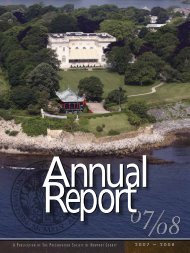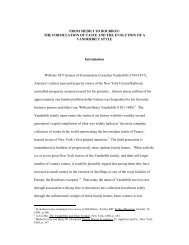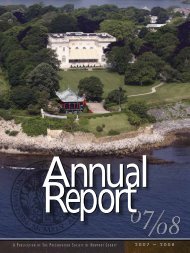The French Connection: Developing a Conservation Treatment Plan ...
The French Connection: Developing a Conservation Treatment Plan ...
The French Connection: Developing a Conservation Treatment Plan ...
Create successful ePaper yourself
Turn your PDF publications into a flip-book with our unique Google optimized e-Paper software.
for wood movement with a plywood panel. <strong>The</strong> cradle is also less finely made and has a different layout<br />
marking system. <strong>The</strong> back of the panel and the cradle are coated with white paint.<br />
On the inside surface of the paper was penciled “Edward Valleby, Newport, RI, May 28, 1895”, who is<br />
thought to be the person who fabricated and applied the cradle and wrapped all with the paper – perhaps<br />
as pre-installation activities. 1895 predates the construction of <strong>The</strong> Elms, suggesting the possibility that<br />
the antique panels, the 4 th large panel, and the overdoor panels were repaired/prepared either by Allard’s<br />
workshops or another shop at some time prior to 1895. Whether they stayed in storage or were installed<br />
elsewhere, the fact remains that by 1901 Allard had installed them to great acclaim in Berwind’s new<br />
home in Newport.<br />
Examination under visible specular, visible raking, and UV light was<br />
important in the appreciation of the character of the surfaces. Level of<br />
gloss of surface or coatings, surface topography, and transmission of<br />
substrate problems were all characterized using visible light. Raking<br />
light was particularly important for judging the extent of disruption of<br />
the lacquer surface. UV light was especially useful for identifying<br />
campaigns and locations of repairs as they were characterized by<br />
varying degrees of autofluorescence (Figure 17). 7 It was also useful<br />
during solvent testing.<br />
Wood Identification<br />
During inspection, a sample approximately 6x3x3mm.was<br />
excised from the back of the east wall panel. Thin sections of<br />
the sample (transverse, radial, and tangential) were prepared<br />
and mounted on glass slides. <strong>The</strong> sections were examined<br />
under the microscope with transmitted light (Figure 18).<br />
Microscopic features entered into the GUESS database suggest<br />
that the specimen is either Podocarpus spp. (Brown Pine) or<br />
possibly Dacrydium spp. [19].<br />
Figure 17: Interventions are<br />
enhanced in UV light<br />
7 Spectronics Corp., 956 Brush Hollow Road, PO Box 483, Westbury, NY, 11590, USA. Spectroline C-100, handheld lamp, 100<br />
watt long-wave UV<br />
Figure 18: Taxodioid cross-field pitting in<br />
Podocarpus. Photomicrograph by A. Heginbotham.<br />
8





